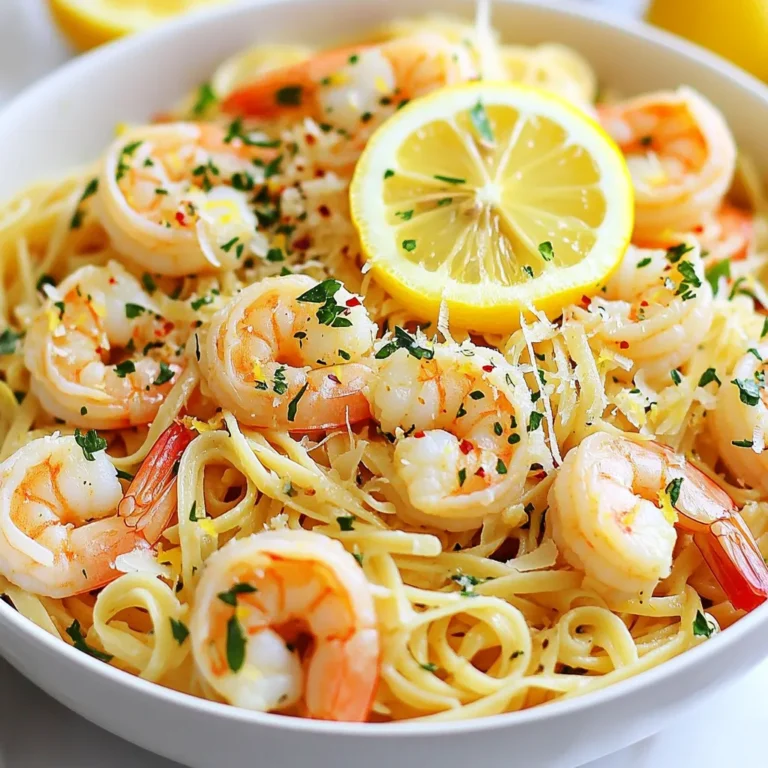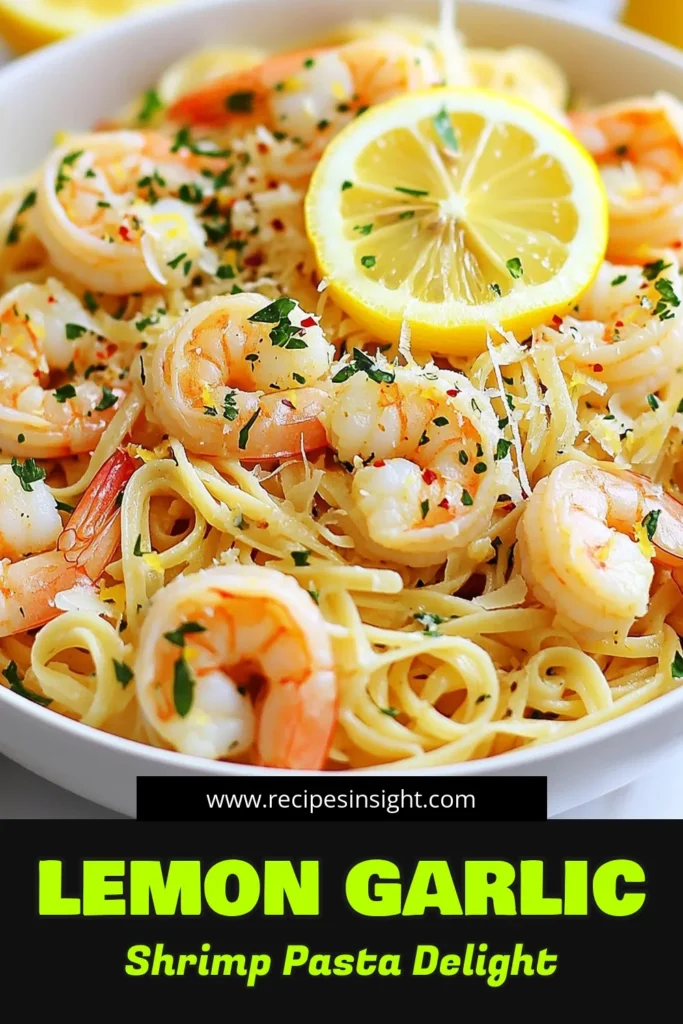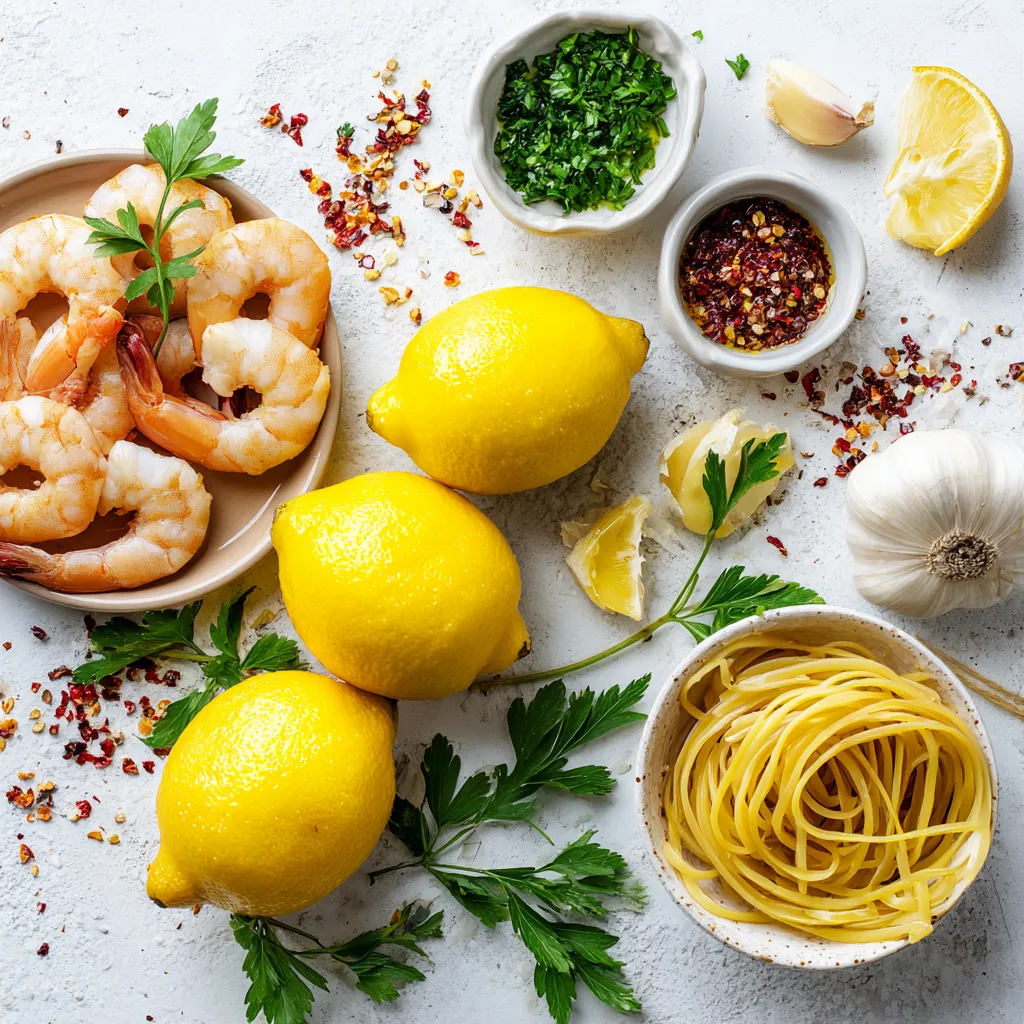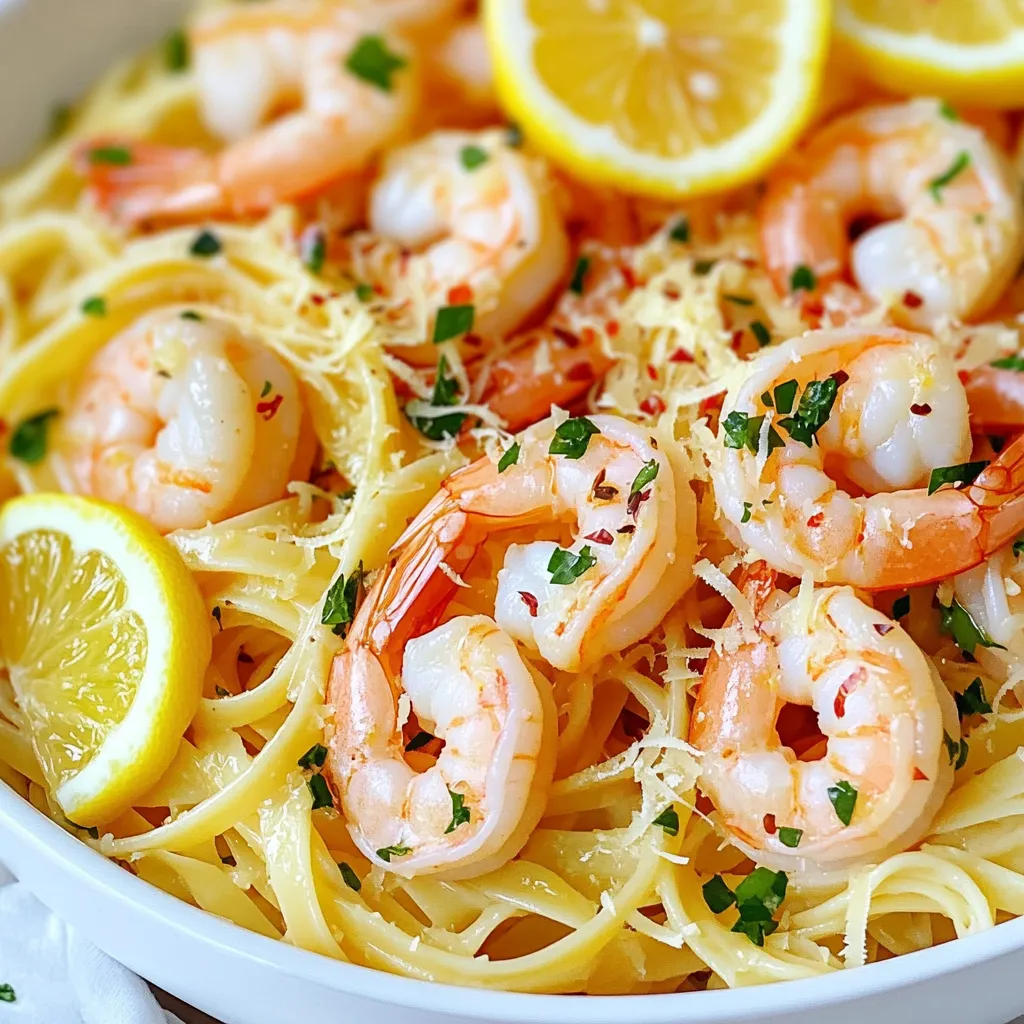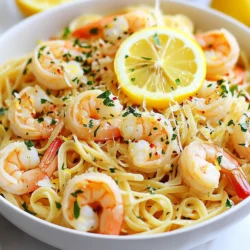WANT TO SAVE THIS RECIPE?
Are you ready to elevate your dinner game? Lemon Garlic Shrimp Pasta is a dish bursting with fresh flavors and simple steps. This recipe packs a punch with succulent shrimp, zesty lemon, and a touch of garlic. Perfect for busy weeknights or impressing guests, it’s both quick and delicious. Let’s dive into the tasty world of Lemon Garlic Shrimp Pasta and whip up a meal that will leave everyone craving more!
Why I Love This Recipe
- Fresh and Flavorful: This dish combines the bright citrus notes of lemon with the savory depth of garlic, creating a refreshing flavor profile that elevates the shrimp and pasta.
- Quick and Easy: With a total cook time of just 20 minutes, this recipe is perfect for a weeknight dinner or when you want to impress guests without spending hours in the kitchen.
- Customizable: You can easily adjust the level of spice by adding more or fewer red pepper flakes or even tossing in vegetables like spinach or cherry tomatoes for extra nutrition.
- Delicious Leftovers: This pasta dish tastes even better the next day, making it a great option for meal prep or enjoying as a quick lunch.
Ingredients
List of Required Ingredients
– 8 ounces linguine or spaghetti
– 1 pound large shrimp, peeled and deveined
– 4 cloves garlic, minced
– 1/4 cup olive oil
– 1/4 cup fresh lemon juice
– Zest of 1 lemon
– 1 teaspoon red pepper flakes (optional)
– Salt and pepper to taste
– 1/4 cup fresh parsley, chopped
– Grated Parmesan cheese, for serving
To make Lemon Garlic Shrimp Pasta, gather your ingredients first. You want fresh shrimp and bright lemons. Use linguine or spaghetti for a nice base. The garlic adds a strong flavor that you will love. Olive oil helps bind everything and gives it richness.
Substitutions and Alternatives
– Pasta alternatives: Try gluten-free pasta if you need it.
– Shrimp substitutes: Use chicken or tofu if you prefer.
– Olive oil alternatives: Butter works well for a creamy taste.
These swaps can make the dish work for you. If you need gluten-free options, many pastas fit the bill. If shrimp isn’t your thing, chicken or tofu can easily take its place. Butter can also replace olive oil for a different flavor. These choices keep the dish fun and flexible!

Step-by-Step Instructions
Cooking the Pasta
Start by boiling salted water in a large pot. Use about one tablespoon of salt for every quart of water. This will help flavor your pasta. When the water reaches a rolling boil, add 8 ounces of linguine or spaghetti. Cook for about 8 to 10 minutes, or until the pasta is al dente. Al dente means the pasta is firm but not hard. Once done, reserve ½ cup of the pasta water and drain the rest. Set the pasta aside and keep it warm.
Sautéing Garlic and Shrimp
Next, heat ¼ cup of olive oil in a large skillet over medium heat. Wait until the oil is hot, then add 4 minced garlic cloves. If you like a little heat, add 1 teaspoon of red pepper flakes too. Sauté the garlic for 1 to 2 minutes until it smells good but does not brown. Browning can make garlic taste bitter. After that, add 1 pound of peeled and deveined shrimp. Season with salt and pepper. Cook the shrimp for about 2 to 3 minutes on each side. They are done when they turn pink and opaque.
Combining Flavors
Once the shrimp are cooked, pour in ¼ cup of fresh lemon juice and add the zest of 1 lemon. Stir it all together to mix the flavors. Let it cook for 1 more minute. Now, add the cooked pasta to the skillet. Toss everything well to coat the pasta in the sauce. If the sauce is too thick, use some of the reserved pasta water. Add it a little at a time until the sauce reaches your desired thickness. Finally, stir in ¼ cup of chopped parsley for freshness before serving.
Tips & Tricks
Enhancing Flavor
– Using fresh herbs for added freshness: Fresh parsley brightens the dish. It adds a pop of color and flavor. You can also try basil or chives. Just chop them and sprinkle on top before serving.
– Adjusting spice level with red pepper flakes: Want some heat? Add red pepper flakes. Start with a pinch and taste. You can always add more if you like it spicy!
– Exploring additional seasoning options: Don’t stop at salt and pepper. Consider adding lemon zest for extra zing. A pinch of oregano or thyme can also bring out new flavors.
Cooking Techniques
– Best practices for cooking shrimp: Shrimp cooks fast. Sauté it for 2-3 minutes until it turns pink. Overcooking makes shrimp tough. Watch it closely!
– Tips for perfect pasta texture: Cook pasta until it’s al dente. This means it should be firm to the bite. Follow package instructions, and taste it a minute before it’s done.
– How to prevent pasta from sticking: Stir pasta while it cooks to keep it from sticking together. Adding a little olive oil to the water can also help.
Presentation Tips
– Serving suggestions with garnishes: Serve pasta in big bowls. Top with extra parsley and lemon slices. This makes the dish look fresh and inviting.
– Bowl arrangement for visual appeal: Twirl the pasta for a nice nest shape. Place shrimp on top, then sprinkle with cheese. It looks great and makes it easier to serve.
– Pairing with side dishes or wine: Lemon garlic shrimp pasta pairs well with a light salad. A glass of white wine, like Sauvignon Blanc, complements the flavors nicely.
Pro Tips
- Use Fresh Shrimp: Fresh shrimp will enhance the flavor and texture of your dish. If possible, buy shrimp from a local seafood market.
- Adjust the Spice Level: If you prefer a milder dish, skip the red pepper flakes or reduce the amount to suit your taste.
- Don’t Overcook the Pasta: Cook the pasta just until al dente, as it will continue to cook in the skillet with the shrimp and sauce.
- Garnish Generously: Adding extra parsley and lemon slices on top not only enhances the visual appeal but also adds fresh flavor.

Variations
Flavor Variations
You can change the taste of your lemon garlic shrimp pasta in fun ways. One great option is to make a creamy version. Just add heavy cream or a dairy-free alternative to the sauce. This will give it a rich and smooth texture.
You can also add some vegetables. Fresh spinach or bright bell peppers add color and health. Just toss them in the skillet when cooking the shrimp for a quick upgrade.
Another idea is to mix in different cheeses. Feta or goat cheese can bring a new flavor twist. Sprinkle them on top before serving for a tasty finish.
Dietary Adjustments
If you want a vegan dish, try using plant-based shrimp. There are many great options out there. They taste wonderful with the lemon and garlic.
For a low-carb meal, swap out regular pasta for zucchini noodles. This change keeps the dish light and fresh. Just spiralize the zucchini and sauté it briefly before mixing in the shrimp.
If nuts are a concern, you can skip them altogether. This will keep the meal safe for those with allergies.
Seasonal Adjustments
In summer, use fresh garden ingredients. Tomatoes, basil, and corn can make the dish feel bright and lively.
In winter, think comfort. Add hearty ingredients like mushrooms or kale. These ingredients will warm you up and add depth.
No matter the season, you can adjust your lemon garlic shrimp pasta to fit your mood and the weather!
Storage Info
Refrigerating Leftovers
To store your leftover lemon garlic shrimp pasta, place it in an airtight container. This keeps it fresh and tasty. You can enjoy it for up to three days in the fridge. Always let it cool down before sealing it. This helps prevent moisture buildup.
Freezing Tips
If you want to freeze your pasta, first let it cool. Then, portion it into freezer-safe bags. Squeeze out extra air before sealing. This will help keep the pasta fresh for up to three months. When you’re ready to eat, thaw it in the fridge overnight before reheating.
Best Practices to Maintain Freshness
When reheating, you want to avoid soggy pasta. The best way to do this is to use the stovetop. Heat a splash of olive oil in a pan and add the pasta. Stir it gently over low heat. If using a microwave, add a little water to the dish and cover it. Heat in short bursts, stirring in between. This way, your pasta stays tasty and firm.
FAQs
How long does it take to make Lemon Garlic Shrimp Pasta?
It takes about 30 minutes to make Lemon Garlic Shrimp Pasta. You will spend 10 minutes prepping ingredients. The cooking time is roughly 20 minutes. This quick dish is perfect for busy weeknights.
Can I make Lemon Garlic Shrimp Pasta ahead of time?
Yes, you can prepare Lemon Garlic Shrimp Pasta ahead of time. Cook the pasta and shrimp separately. Store them in airtight containers in the fridge for up to two days. When ready, reheat the shrimp and mix with the pasta. Add fresh parsley and lemon juice before serving for the best taste.
What can I serve with Lemon Garlic Shrimp Pasta?
Lemon Garlic Shrimp Pasta pairs well with many dishes. Here are some great options:
– A fresh green salad with lemon vinaigrette
– Garlic bread or crusty baguette
– Grilled vegetables, like zucchini or bell peppers
– A chilled glass of white wine, like Sauvignon Blanc
– Lemon sorbet for dessert
These sides enhance the meal and round out your dining experience. Enjoy!
Lemon Garlic Shrimp Pasta is a simple yet tasty dish. You learned about the key ingredients and how to prepare them step by step. We covered tips to enhance flavors and variations for dietary needs. Now you know how to store leftovers and how to reheat them properly. This dish is flexible, allowing you to impress friends and family. Try it out and create your own version! You will enjoy the fresh flavors and ease of making this mea
Lemon Garlic Shrimp Pasta
A delicious and easy pasta dish featuring shrimp sautéed in garlic and lemon.
Prep Time 10 minutes mins
Cook Time 10 minutes mins
Total Time 20 minutes mins
Course Main Course
Cuisine Italian
Servings 4
Calories 400 kcal
- 8 ounces linguine or spaghetti
- 1 pound large shrimp, peeled and deveined
- 4 cloves garlic, minced
- 1/4 cup olive oil
- 1/4 cup fresh lemon juice (about 2 lemons)
- 1 unit Zest of 1 lemon
- 1 teaspoon red pepper flakes (optional)
- to taste Salt and pepper
- 1/4 cup fresh parsley, chopped
- for serving Grated Parmesan cheese
In a large pot, bring salted water to a boil. Add the linguine or spaghetti and cook according to package instructions until al dente. Reserve 1/2 cup of pasta water, then drain and set aside.
In a large skillet over medium heat, add the olive oil. Once hot, add the minced garlic and red pepper flakes (if using). Sauté for about 1-2 minutes until the garlic is fragrant but not browned.
Add the shrimp to the skillet, seasoning with salt and pepper. Cook for about 2-3 minutes on each side, or until the shrimp turn pink and opaque.
Once the shrimp are cooked, pour in the lemon juice and lemon zest. Stir to combine, allowing the flavors to meld for another minute.
Add the cooked pasta to the shrimp mixture in the skillet. Toss well to coat the pasta in the sauce, adding reserved pasta water a little at a time if needed to loosen the sauce.
Remove from heat and stir in the chopped parsley. Taste and adjust seasoning, if needed. Serve immediately, topped with grated Parmesan cheese.
Serve the pasta in large bowls, topped with extra parsley and lemon slices for an attractive finish.
Keyword garlic, lemon, pasta, shrimp
WANT TO SAVE THIS RECIPE?
